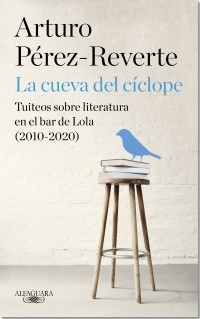Prensa > Críticas en otras lenguas
Críticas en otras lenguas
Críticas publicadas en otros idiomas.
The Battle-Scarred Hero’s (Near) Legacy in Art (El Sol de Breda)
JANET MASLIN | New York Times - 30/3/2007
In the midst of the Dutch and Spanish dignitaries in the
foreground of Diego Velázquez's war tableau "The Surrender of Breda,"
there is a small open space beneath one soldier's horizontal weapon. It
appears to depict the back of the soldier beside him. But it is the
suggestion of Arturo Pérez-Reverte's latest installment in his grandly
entertaining Captain Alatriste series that Alatriste, he of the cold
gray-green eyes and dauntless courage, was once part of the picture -
although his likeness has since been excised.
Was he painted by Velázquez? The claim that he was comes from no less
an authority than Íñigo Balboa, Alatriste's hero-worshiping young
companion. Íñigo also claims to have described to Velázquez the visual
details of the surrender. Mr. Pérez-Reverte has shaped his third
Alatriste book, "The Sun Over Breda," around this famous painting. In
contrast to the more narrative-driven earlier books, "Captain Alatriste"
and "Purity of Blood," this one unfolds on Flemish battlefields rather
than in Spain.
So most of the series's usual, highly enjoyable villainy has been put
aside. Enchanting characters like Angélica de Alquézar, she of the
"blond corkscrew curls and eyes as blue as the sky over Madrid," with "a
smile identical to the devil's when, through Eve's intercession, he
tempted Adam to sink his teeth into the fabled apple," will have to wait
until next time.
Although Íñigo's narration occasionally recapitulates earlier plots
(and flashes forward to the time when he is much older, remembering
these glory days), the present book's action is ferociously combative.
Mr. Pérez-Reverte, who was once a war correspondent, pieces together the
bloody events that led to the Breda surrender in 1625.
Beginning at a drawbridge in the strategically located city of Oudkerk
and moving relentlessly, at one point even tunneling beneath a
graveyard, an army - including Valencians, Andalusians, Castilians,
Galicians, Basques, Aragonese and Portuguese soldiers - progresses
toward the climactic siege of Breda. The sun in the book's title refers
to a bitterly victorious Spain.
The Spanish have grown cynical and tired. Spanish fighters "had been
waging war against the entire world for a long century and were
beginning to not know precisely why, whether it was to defend
indulgences or to enable the Court of Madrid to continue believing,
amidst its balls and soirées, that it still ruled the world," writes Mr.
Pérez-Reverte, who has deeply immersed himself in this period in
Spanish history while remaining well aware of the present day.
As one character puts it concisely, "We Spanish have fewer tears than
reasons to weep, for it is a vain labor to offer light to the blind,
words to the deaf, science to the ignorant, and honor to monarchs."
If the suffering inflicted by the Thirty Years' War is a constant in
these books, so is the laconic demeanor of Alatriste. Mr. Pérez-Reverte
repeatedly uses the same terms to describe him. Alatriste has a
battle-scarred face, a mustache used for thoughtful twirling, a hat that
half hides his cryptic eyes and, only occasionally, a half-smile. He
also has astonishing courage and resilience that make the heroism in
these books so compelling. And he has a way with the ladies.
But Alatriste's character is relatively underutilized this time. And
his dialogue is strong, but minimal. "Captain Alatriste is as he always
is, with little meat on his bones and few words in his mouth," Íñigo
writes in a letter. But the book is full of moments, as when Alatriste
sleeps beside Íñigo and wordlessly offers his cape to keep the boy warm,
that speak for themselves.
Like Velázquez's painting "The Sun Over Breda" has a large canvas. Mr.
Pérez-Reverte incorporates the principals of the scene - which shows a
key to the city of Breda being transferred from a Dutch leader to a
Spanish one - into the book's earlier action. Even the blue and white
banner in the painting is accounted for. He also gives a detailed view
of the soldiers' ordeal, from their near-mutiny over not being paid to
their deep fortitude during even the grisliest moments of battle. All of
this eclipses the kind of scheming, swashbuckling fun these books have
delivered in the past, but still makes for a vigorous installment.
As always, Íñigo's highly opinionated narration delivers much color.
"In the trenches, not content with living like kings in our hair and our
rags, lice would come out and stroll around like Madrid gentlemen," he
tells the reader. "You would have said that the devil was vomiting
heretics, for this was the third time they had charged us," he says of
one battle.
But Íñigo also has an eye for every last pike and harquebus, and for
the laborious details of a long siege. "They had already dug three
anchorages lined with rubblework and were progressing from both sides,
containing the mud with large wood retaining walls and securing the
locks with pontoons and palisades," he explains, showing why the
soldier's work was so difficult - and why these books' usual rescues,
betrayals, romances and literary disputes are more appealing than its
large tableaus.
Mr. Pérez-Reverte's latest cliffhanger promises a return to more
intimate plotting. Exactly who removed Alatriste not only from the famed
painting but from a play written about the Breda siege? A passage
presented as a scholarly editor's note speculates in general terms about
these acts of spite. Surely the insult will be made more personal next
time Alatriste returns





